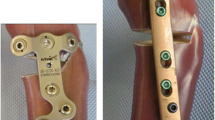Abstract
High tibial osteotomy in the varus knee has been successfully performed for a long time. Several newer operation techniques have been established in recent years. We tested the primary stability of several of these techni-ques in vitro. Ten human cadaveric fresh-frozen specimens were used that had a mean age of 54 years (range 29–¶72 years) and a weight of 55–85 kg. All specimens were harvested, frozen, and subsequently thawed under the same conditions before testing. The following implants were tested: one-third tubular plate with a cortical screw (AO, Synthes), blade plate with screws (Giebel’s plate, Link), bone staples (osteotomy staples, Krackow staples, Smith & Nephew) and an external fixator (Orthofix). The specimens were mounted in metal cylinders and then loaded in two different setups: transverse forces were applied to the osteotomy site by hanging weights parallel to the osteotomy plane in a static-loading frame, and axial forces were applied by a materials testing machine (Zwick). Displacement was recorded using a linear variable displacement transducer (LVDT). The highest stability was achieved by the external fixator and the bone staples. Giebel’s blade plate and the one-third tubular plate were less stable. Retention of an intact medial cortex was a decisive factor in obtaining primary stability. We found that the primary stability of the tested devices was generally comparable as long as they were correctly implanted. It was also noted that lateral spacing of the osteotomized bone should not exceed 3 mm. If the medial cortex is transected intraoperatively in lateral osteosynthesis, an additional medial implant is necessary to ensure sufficient primary stability. For practical reasons it was necessary to neglect the contribution of the soft tissues around the knee, although all implants were tested under the same conditions. Care should thus be taken when interpreting the results of this study in a clinical setting.
Similar content being viewed by others
Author information
Authors and Affiliations
Additional information
Received: 3 June 1998
Rights and permissions
About this article
Cite this article
Flamme, C., Kohn, D., Kirsch, L. et al. Primary stability of different implants used in conjunction with high tibial osteotomy. Arch Orth Traum Surg 119, 450–455 (1999). https://doi.org/10.1007/s004020050019
Issue Date:
DOI: https://doi.org/10.1007/s004020050019




